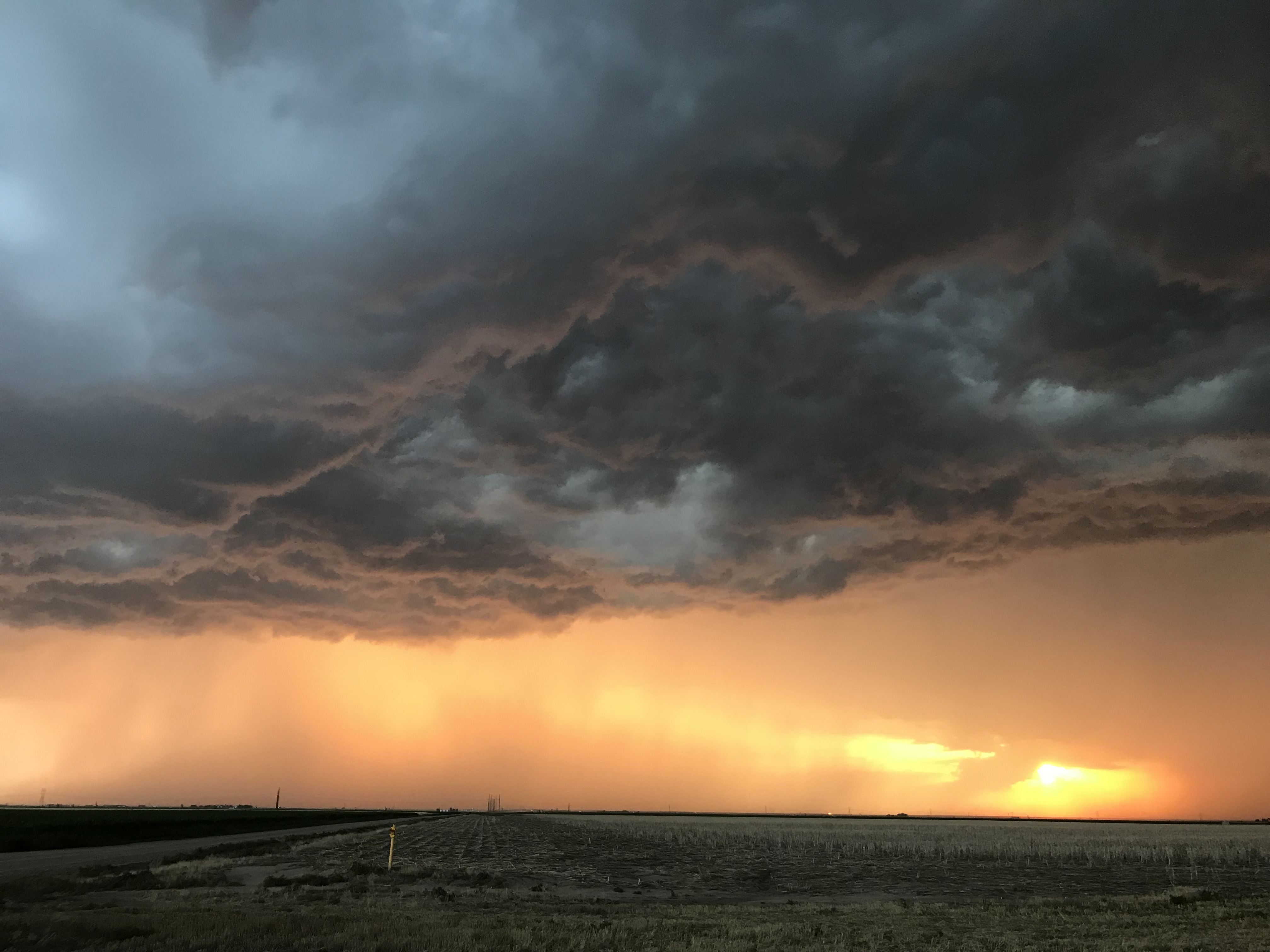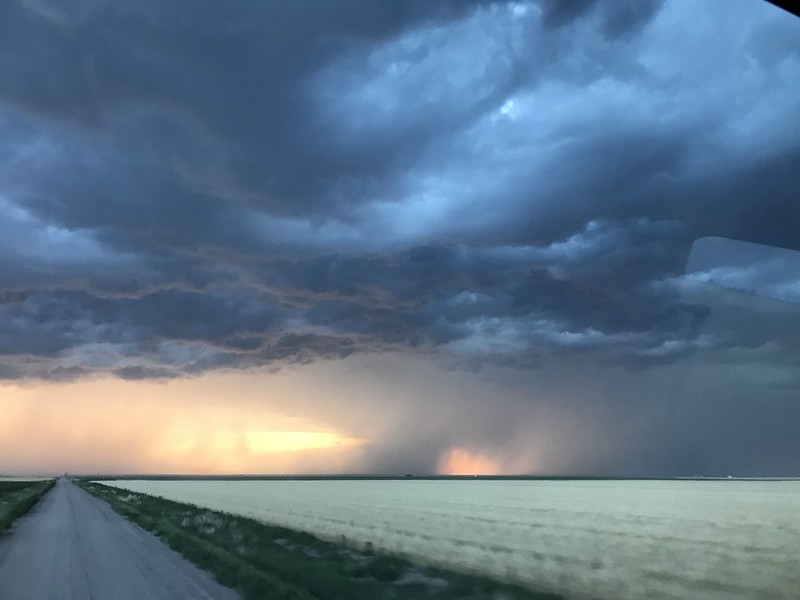
11 Jul Tracy: 10 Ways Disastered Crops Affect the Harvest
Limon, Colorado – The custom harvester continues to struggle with the 2018 harvest season.
What began in May with severe drought in the southern states and the late season freezes, continues now with the nasty four-letter word…hail. If you haven’t experienced it yourself, the images on social media will provide you with a pretty good idea of what we’re up against.
I honestly believe when a farmer plants and cares for a crop, he doesn’t do it with the hope of harvest being eliminated by the Great White Combine. If that’s the case, why even farm?
 Photo credit to Amanda Buus Thomsen of BT Harvesting.
Photo credit to Amanda Buus Thomsen of BT Harvesting.
Two major hail storms occurred in Onida and Pierre, South Dakota within three days of each other. The path of these storms was measured in hundreds of miles and 1,000’s of acres. The Onida Watchman reported over 200,000 acres of crop and pastures were destroyed. This area is a destination for many harvesters. But not now. Some of the same harvesters shaking their heads over the most recent devastation are the same ones who either did not cut a lick of wheat down south…or their acres were majorly reduced.
Not only has the hail eliminated a lot of wheat acres, it didn’t bother to skip over the fall crops as it marched across the vast countryside. Any hope of harvesting corn, soybeans, sunflowers or canola this fall has been diminished.
 Photo credit goes to Grant Watermann with Watermann Farms Custom Harvesting.
Photo credit goes to Grant Watermann with Watermann Farms Custom Harvesting.
 Photo credit goes to Loree Osowski with Osowski Harvesting.
Photo credit goes to Loree Osowski with Osowski Harvesting.
The pictures on social media tell the story. There’s nothing left to harvest. Done!
As we all know, pictures are shared and they’re shared again and again. What I don’t get, though, are some of the comments left (these are actual comments):
“Whys everyone sad about this? Get hail insurance and you’ll be better off financially with that than with the crop and hassle of dealing with harvest and trucking all the grain and storing it!”
“Hope it was insured make for a good pay day with the right policy.”
Then there’s the image of a hailed corn field with a can of beer placed in the middle of the picture. The caption reads, “I made money today.”
As a harvester, these words cut deep in my soul.
 Photo credit goes to Kent Braathen with Braathen Harvesting.
Photo credit goes to Kent Braathen with Braathen Harvesting.
I’m the first one to say we all rely on the farmer. We do! If there were no farmers, there would be no food. I’ve always said the farmer needs whatever they need to continue to do the job they do. Period. If that need is in the form of crop/hail insurance, so be it. But I wish the attitude wasn’t “hoping for a hail storm to eliminate the harvest”. Eliminating the harvest eliminates the harvester.
So here’s my hope…to educate you about ten ways a disastered crop affects the harvest and the harvester:
- The harvester.
No crop for the farmer to harvest = no payday for the custom harvester. If the crop is gone, so is our income. When we pack up and leave for the summer with our families and our equipment, we anticipate working. We want to work! Our industry does not have any sort of safety net when it comes to loss of acres. So we need to work!
- Equipment payments.
They still need to be made.
When most of us make the decision to trade our equipment, it’s done before the end of December. It’s too late to change our minds in April when news of the drought and late season freezes start making the headlines. Throw major hail in the picture and it gets VERY serious. The custom harvester tries to keep their equipment up-to-date. Not because they want the newest and shiniest…it’s because they can’t be on the road with combines and trucks that are in constant need of repair. Having new combines and/or trucks doesn’t mean the harvester is rich beyond belief. That’s so far from the truth. What they are hoping for is less down time in the fields and on the highways. No one wants equipment broke down when there’s a crop that needs harvested.
- Replacement acres.
There are less acres of wheat planted now since records began to be kept in 1919. When Mother Nature wipes out acres that are planned on, it’s very difficult to find more to make up for what has been lost.
- Price cutting.
Cheaper rates charged by harvesters who feel they can take a cut in pay just to keep working…to help pay for those expenses that continue until the next job is ready. I personally don’t understand how they can justify a cut in pay. As it is, the current rates provide us with minimal profit.
- The trickle-down effect.
Communities count on the Wheaties to show up at harvest time. If we’re not there, the café owner suffers, the bar owner suffers, the grocer suffers, the RV park owner suffers, the fuel man suffers, the parts man suffers, the barber suffers, the convenient store suffers, etc. We bring a substantial economic boost to the towns we pull into and call home for ten days to two weeks.
- Grain elevator employees.
Additional jobs created for harvest time may be eliminated if there is no crop to cut.
 Those guys in the back of my truck are a very important part of the harvest. Without them back there, I would be getting in and out of the truck multiple times to dump the loaded truck. They stand in the dirt and chaff watching the box as it’s raised to make sure it doesn’t hit anything, they make sure the wheat is dumping as it should and they clean up as I’m driving away. They are also the ones looking for just a little bit of shade when it’s 110 degrees. Not many would want this job!
Those guys in the back of my truck are a very important part of the harvest. Without them back there, I would be getting in and out of the truck multiple times to dump the loaded truck. They stand in the dirt and chaff watching the box as it’s raised to make sure it doesn’t hit anything, they make sure the wheat is dumping as it should and they clean up as I’m driving away. They are also the ones looking for just a little bit of shade when it’s 110 degrees. Not many would want this job!
- Harvester’s employees.
They take the job hoping to run the equipment and do the job that needs to be done. Without the work, some get discouraged and leave. This leaves the harvester with a mess trying to find additional employees during the middle of harvest.
- Diesel purchases.
Required for the pickup used to run around the country pinning business cards and flyers to bulletin boards in hopes of finding replacement acres.
- Over-the-road expenses.
In addition to the already mentioned equipment payments, there is insurance, workers comp, food, lodging, labor, fuel, tires, repairs, etc. These don’t quit because there are no acres to cut.
- Satisfaction.
The satisfying feeling after the final truck of grain has been dumped in the bin or hauled to the elevator. If there is no crop, this feeling of completeness has been eliminated.
- Joy.
I said ten but this one is important. It doesn’t allow you to experience the sweet smell of wheat chaff blowing out the back of the combine. Or the excitement of what it takes to bring in the harvest.
All Aboard Wheat Harvest™ is sponsored by High Plains Journal and John Deere. Tracy Zeorian can be reached at zcrew@allaboardharvest.com.


Sorry, the comment form is closed at this time.